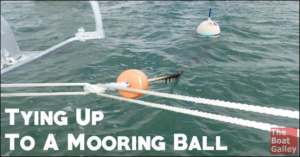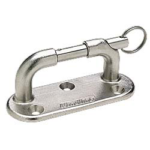Town of Falmouth Mooring Regulations
Click the blue link to open: Falmouth Mooring Ordinance
Mooring Anchor
The Town of Falmouth will want you to have a 300 lb mushroom anchor, or alternatively, a 1200 lb granite block. Probably overkill for an Etchells, but you will find that most moorings in the field use overly short anchor scope (in my opinion), and you will want to match the scope of your neighbors in the mooring field so you all swing together in similar sized watch circles. So, having an extra heavy anchor will help you sleep better at night when there is a stiff gale blowing.
Anchor Scope
Some authorities recommend the anchor scope in a protected harbor should be at least 2 to 2-1/2 times the sum of the water depth at high tide plus the freeboard at the bow. (Note, the marine insurance companies often put out written guidance for moorings, and they recommend a scope of at least 4.5 with a mushroom anchor!) The Town of Falmouth ordinance says the scope should be “approximately 2” times the water depth, so the town is shortchanging the safety of your boat by at least 2 times the freeboard. Plus, the Falmouth mooring field is more exposed than a typical protected harbor. Be that as it may, if we accept for the moment that a scope of 2 is adequate, if the charted depth (referenced to lower low water!) is 25 feet, and there is 12 feet of tidal increase to the higher high tide level, that is 37 feet of water depth. Plus, 2-1/2 feet for the Etchells freeboard at the bow brings the total vertical distance to 39.5 ft. Two times that is 79 feet (using a more prudent scope ratio of 2-1/2 times results in 99 feet!). The anchor scope is comprised of the sum of bottom and top chain lengths, plus the pennant length from the mooring buoy to the deck edge. The pennant might be about 14 feet measured to the deck edge, so subtracting that, you would need at least (79 – 14) = 65 feet of chain (actually, ~85 feet of chain would be the more prudent length of chain giving a scope ratio of 2-1/2).
There was a survey of the Falmouth mooring field done a few years ago, with a report published in 2008. Most moorings in the Falmouth mooring field have 40 to 50 feet of chain, no matter what the local water depth is. There are a very few moorings with over 60 feet of chain. So be it.
Moor to the Mast
Most people secure the mooring pennant around the mast at deck level, using a pair of dock lines that pass through the eye in the mooring pennant. Since you are tying bowlines around the mast with each end of a dock line, using a second dock line through the pennant eye is good insurance against one of the knots working loose. However, some people have installed a cleat on the bow (forward of the headstay) to secure the pennant and remove any need to tie knots, which are a common failure point.
Pennant Wisdom
 If you use a pair of dock lines through the mooring pennant eye, and the mooring pennant remains out in front of the boat, rig your 2 dock lines as shown in this photo. There will be less chafe this way compared to if each is line tied in a “bridle shape” around the bow (i.e., one end leading over the starboard bow and the other end over the port bow). Plus, your boat will skate around less on the mooring.
If you use a pair of dock lines through the mooring pennant eye, and the mooring pennant remains out in front of the boat, rig your 2 dock lines as shown in this photo. There will be less chafe this way compared to if each is line tied in a “bridle shape” around the bow (i.e., one end leading over the starboard bow and the other end over the port bow). Plus, your boat will skate around less on the mooring.
Bow Chock

A bow chock can be effective at holding the bow into the wind and preventing the boat from skating around on its mooring. These Windline LC-1 stainless steel locking bow chocks (photo, left) are great, if you can find one on eBay – they have not been produced for a number of years. If you find one, mount it as far forward as you can, near the deck edge using a backing plate under the deck (but ensure not too close to the deck edge, or there won’t be room under deck for the backing plate and washers). You will need to crawl up in the bow tank, as far forward as you can, and then some. You probably want the chock’s closure pin to slide open aft so the spinnaker gear has less to get hung up on. Maybe if there is interest we could get a few made, possibly incorporating some improvements (such as a rolled outer edge to the base plate to provide chafe protection to the deck edge) specifically for our Etchells.
Maintenance note: this chock has a 3/32″ diameter by 5/16″ long spring (roll) pin inserted into the keeper bolt to prevent the bolt from being lost. Extensive testing has demonstrated that these spring pins last less than 2 years in the marine environment before they corrode and fall off, putting the keeper bolt at risk of being lost overboard. The OEM spring pins are probably a low grade stainless steel. McMaster-Carr sells 18/8 spring pins in packages of 50 (which I now have in ample supply), although SS316 would be a better material if a supplier could be found. Take the keeper bolt home to drill out the remains of the old spring pin with a 5/64″ cobalt coated drill bit.
Another candidate for a bow chock is one used on the Atlantic class (p/n C13) or on the Shields class (p/n B30). These chocks are made by the boat builder, Cape Cod Shipbuilding in Wareham, Mass. They likely will be chrome plated cast bronze.

An alternative to a bow chock is to tie (loosely) the dock lines/pennant to the small eye strap on the bow. You can use a sail tie or small line. Check to make sure that the bow eye fitting is in good shape. I have seen some that are badly corroded or have a broken leg on the eye. This setup works well, but it is just one more thing in the mooring system that needs to be tied correctly.
Does any of this matter?
I used to sail on Etchells #796, and none of these pennant restraints were used when mooring that boat. The dock lines were not attached per the photo, but just run through the pennant eyes in a bridal configuration, and the ends tied off at the mast. There were no restraining lines tied to the bow eye. The boat did skate around a lot at the mooring, but other than that, it survived fine.
As I write this, the charted depth where my current boat is anchored is 29 feet. My mooring pennant is 14 ft long. So, by my reckoning, I should have at least {(29 + 12 + 2.5) x 2.0} – 14 = 73 feet of chain (for a scope ratio of only 2.0). But there is only 50 ft of 5/8-inch chain on my mooring. The mooring was assembled, installed, and continues to be serviced by one of the local mooring services, who ignored my scope arithmetic when he installed my mooring, insisting 50 feet was sufficient chain length (apparently, nearly all the moorings in the field use 50 ft, no matter what the charted water depth might be). There was a period this summer when the buoy was pulled completely underwater during high tides, probably due in part to chain wrap/twist. But the boat remains moored at the same GPS coordinates, even though there have been several stormy days since the mooring was installed a couple years ago. Maybe luck plays a part. I am glad the anchor is extra heavy.

To keep the mooring pennant close to the bow, I have a stainless bow deck eye forward of my headstay. It is not strong enough to hold the pennant but an 18″ piece of 3/16″ line left in this eye works wonderfully to loosely wrap around the pennant to hold it 6″ or so from the eye. This keeps the boat nicely aimed at the mooring ball at all times.
WhiteHawk uses a Yale pre spliced pennant from the ball to the pickup buoy with a 5′ pole for easy grasping. A 4′ strap of 3/4″ braided nylon with a snap shackle at one end and an eye spliced nylon thimble on the other wraps around the mast and through the pennant eye, this takes only seconds to affix and has yet to self release after 5 years. A second 5′ piece of nylon has been spliced to the pennant and this gets a quick bowline around the mast as a safety backup. this has never been tested but allows me to sleep better knowing it is there. For those wanting a line to the keel bolt ring, the backup line could be 10-12′ long and and this gets bowlined to one of those rings.